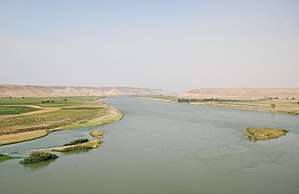Battle of the Bridge
The Battle of the Bridge or the Battle of al-Jisr (Arabic: معركة الجسر) was a battle at the bank of the Euphrates river between Arab Muslims led by Abu Ubaid al-Thaqafi, and the Persian Sasanian forces led by Bahman Jaduya. It is traditionally dated to the year 634, and was the only major Sassanian victory over the invading Muslim armies.
Context
The Muslim forces had already taken Hira and assumed control of the surrounding Arab-inhabited areas of Mesopotamia, on the banks of the Euphrates.[8] The fall of Hira shocked the Persians, as the "youthful Yazdgard, began to take the business of the Arabs more seriously."[8] Yazdgard sent forces to the Arab border areas, and looked to be gaining the upper hand, as Al-Muthanna had to call for reinforcements from Medina.[8]
The new Caliph, Umar, sent Abu Ubaid to Mesopotamia to take command from Al-Muthanna. He encountered the main Persian force under Bahman Jaduya, near what is the present site of Kufa. The two forces faced each other on opposing banks of the Euphrates. As it was crossed by a bridge, the battle came to known as the Battle of the Bridge.[8]
Battle
Bahman invited Abu Ubayd to decide who should cross the river.[6] The latter took the initiative, and crossed the river aggressively; this proved to be disastrous. According to accounts, the sight of the elephants in the Persian army frightened the Arabs' horses. A white elephant apparently tore Abu Ubaid from his horse with its trunk, and trampled him under foot. At this, and the inability of the Arab troops to push back the Persians who had formed a rigid line close to the bridge, the Arabs panicked and fled.[8][6] After Abu Ubayd the command was taken by al-Hakam and Jabr, his brother and son, respectively, and eventually al-Muthanna.[3] According to tradition, Al-Muthanna remained to fight so that the Arabs could repair the bridge and flee losing 4,000 men, - although any accurate estimates of the figures involved in this and other contemporaneous battles are not known.[8] Around 3,000 Arab Muslims were carried away by the river.[9]
Sources agree that for whatever reason, Bahman Jaduya did not pursue the fleeing Arab army.[8]
See also
- Muslim conquest of Persia
- Fall of the Sasanian Empire
- Battle of al-Qādisiyyah
References
- electricpulp.com. "ʿARAB ii. Arab conquest of Iran – Encyclopaedia Iranica". www.iranicaonline.org. Retrieved 2018-07-19.
Ambushing Abū ʿObayd from the opposite bank of the Euphrates, the Persians inflicted a disastrous defeat on the Muslim forces at the Battle of the Bridge in Šaʿbān, 13/October, 634.
- Brown, Daniel W. (2011-08-24). A New Introduction to Islam. John Wiley & Sons. p. 107. ISBN 9781444357721.
- Biladuri 2011, p. 404.
- al-Tabari 2013, p. 193.
- al-Tabari 2013, p. 188.
- Nafziger & Walton 2003, p. 22.
- Pourshariati 2011, p. 217.
- Frye 1975, p. 8-9.
- Crawford 2013, p. 134.
Sources
- Al Biladuri, Ahmad Bin Yahya Bin Jabir (2011). The Origins of the Islamic State: Being a Translation from the Arabic. Translated by Hitti, Philip Khuri. Cosimo Classics.CS1 maint: ref=harv (link)
- al-Tabari, Muhammad ibn Yarir (1993). he History of al-Tabari Vol. 11: The Challenge to the Empires A.D. 633-635. Translated by Blankinship, Khalid Yahya. State University of New York Press.CS1 maint: ref=harv (link)
- Crawford, Peter (2013). The War of the Three Gods: Romans, Persians and the Rise of Islam. Pen & Sword.CS1 maint: ref=harv (link)
- Frye, Richard Nelson (1975). The Cambridge History of Iran: The period from the Arab invasion to the Saljuqs. Cambridge University Press.CS1 maint: ref=harv (link)
- Nafziger, George F.; Walton, Mark W. (2003). Islam at War: A History. Praeger.CS1 maint: ref=harv (link)
- Pourshariati, Parvenah (2011). Decline and Fall of the Sasanian Empire. I.B.Taurus & Co.Ltd.CS1 maint: ref=harv (link)
